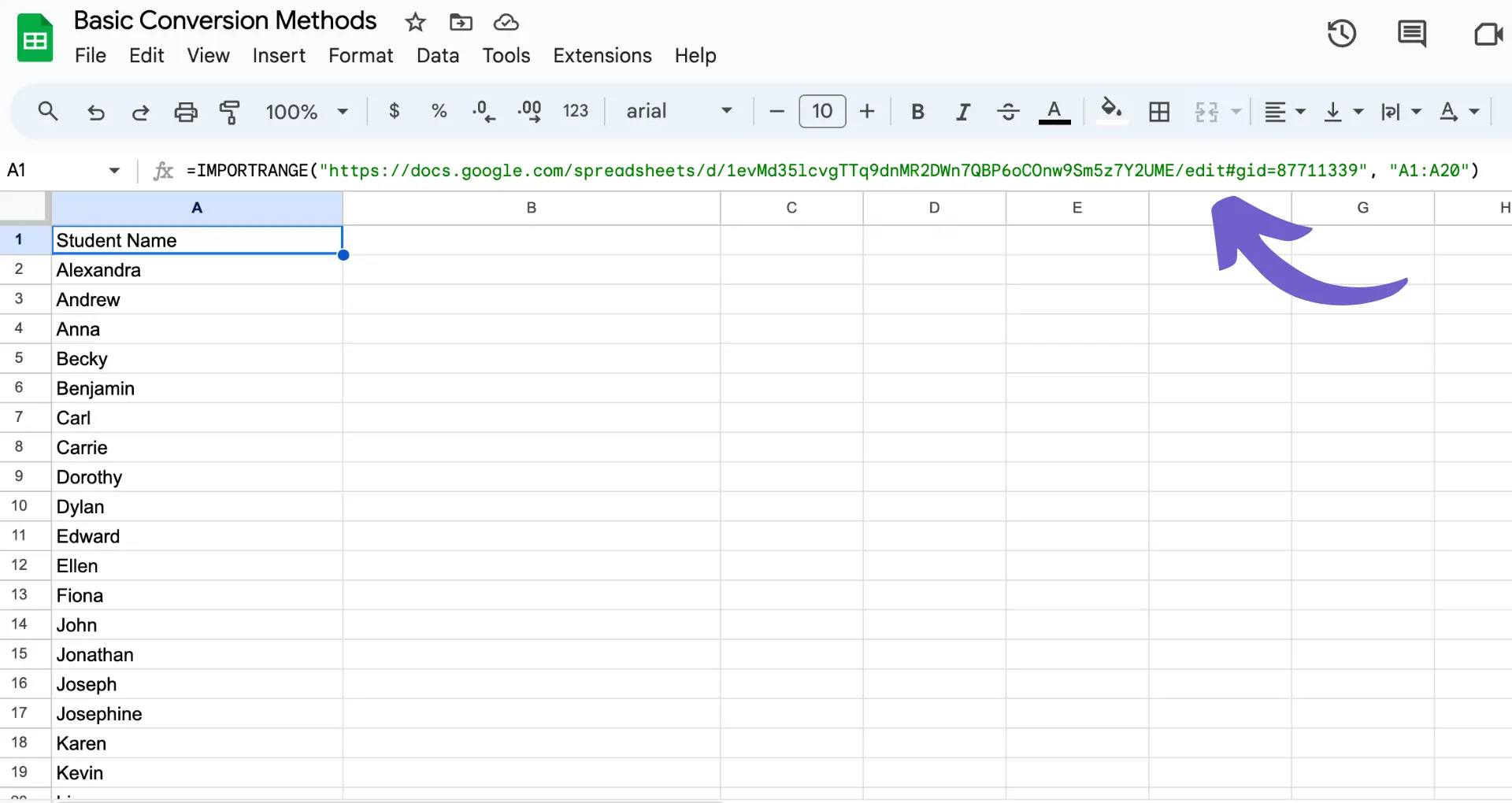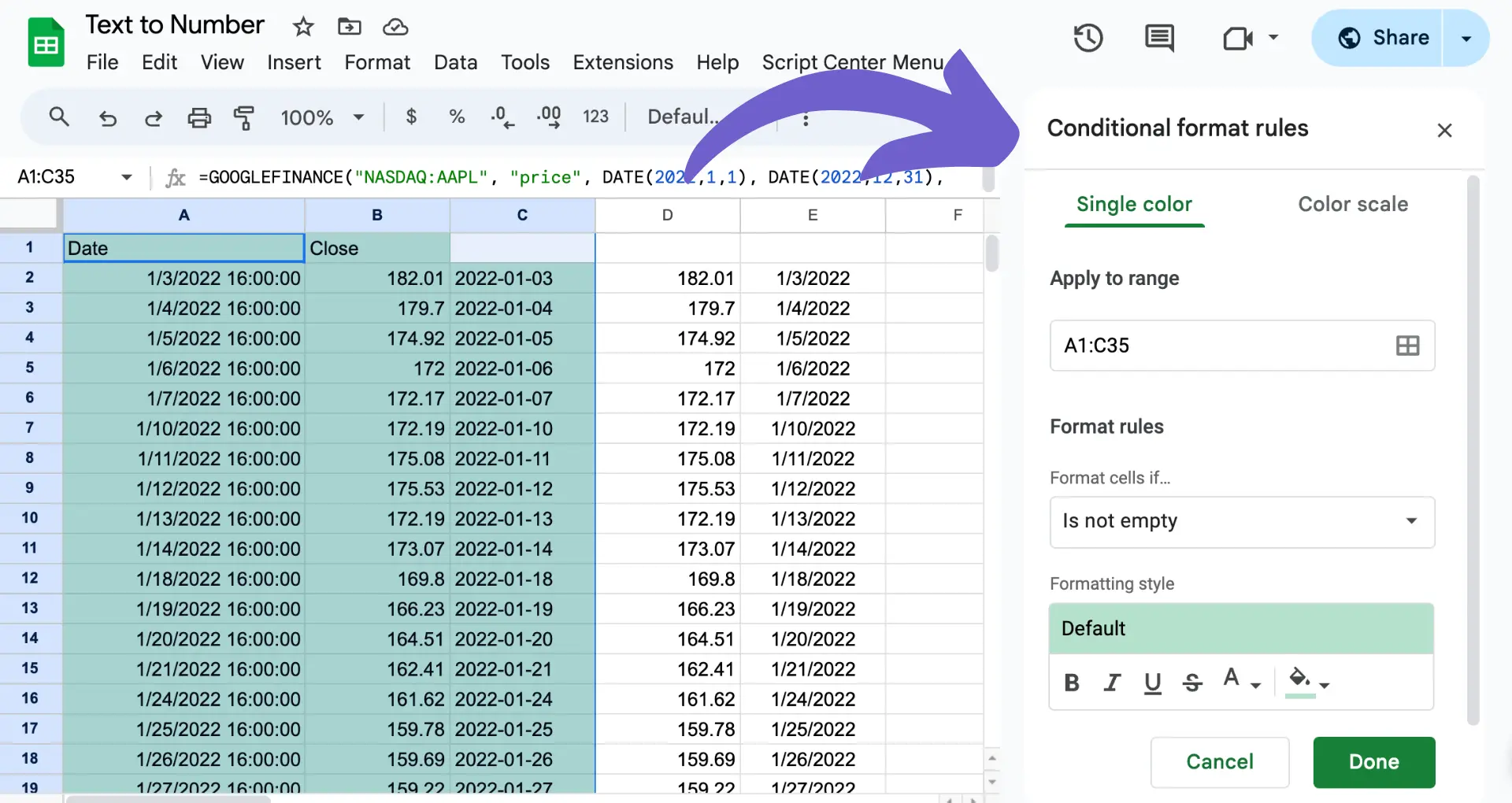





Use IMPORTRANGE to pull data from one Google Sheet to another.
By the way, we're Bardeen, we build a free AI Agent for doing repetitive tasks.
If you work with spreadsheets, you might love Bardeen's GPT in Spreadsheets feature. It helps automate data tasks and saves you time.
The IMPORTRANGE function in Google Sheets is a powerful tool that allows you to easily pull data from one spreadsheet into another. Whether you're working with large datasets or need to combine information from multiple sources, IMPORTRANGE streamlines the process and saves you time. In this step-by-step guide, we'll walk you through how to use IMPORTRANGE effectively, from understanding the basics to mastering advanced techniques and troubleshooting common issues.
IMPORTRANGE is a function in Google Sheets that allows you to import data from one spreadsheet into another. It's a powerful tool for combining data from multiple sources or working with large datasets across different sheets. The primary syntax for using IMPORTRANGE is:
IMPORTRANGE("spreadsheet_url", "range_string")

When using IMPORTRANGE for the first time between two spreadsheets, you'll need to grant permission for the destination sheet to access data from the source sheet. This ensures data security and prevents unauthorized access. For more advanced features, you can bring AI into your spreadsheet to enhance your workflow.
To start using IMPORTRANGE, open a new or existing Google Sheet where you want to import the data. In an empty cell, type the following formula:
=IMPORTRANGE("spreadsheet_url","range_string")
Replace "spreadsheet_url" with the URL of the source spreadsheet, enclosed in quotation marks. You can find the URL in the address bar when viewing the source spreadsheet.
Next, replace "range_string" with the range of cells you want to import, also enclosed in quotation marks. Use the format "Sheet1!A1:B5", where Sheet1 is the name of the sheet and A1:B5 is the range of cells.
Press Enter to complete the formula. If this is the first time you're importing data between these two spreadsheets, you'll see a #REF! error. Click on the error and select "Allow access" to grant permission for the destination sheet to access data from the source sheet.
Once permission is granted, the imported data will appear in your destination sheet. Any changes made to the source data will automatically update in the destination sheet, ensuring you always have the latest information. For more complex workflows, you can connect Google Sheets with other apps to automate your tasks.
Automate importing and updating data across sheets quickly. Integrate Google Sheets with Bardeen to connect your sheets and save time.

When using the IMPORTRANGE function, you may encounter some common errors. Here are the typical errors and how to resolve them:
The #REF! error occurs when the IMPORTRANGE formula is unable to find the specified sheet or range. This can happen if:
To fix this error:
The #ERROR! error typically indicates a problem with the IMPORTRANGE formula syntax. Common causes include:
To resolve this error, carefully review the formula and ensure that the syntax is correct, with proper quotation marks and no extra spaces.
When you first use IMPORTRANGE to connect two spreadsheets, you may see a "Loading..." error. This is not actually an error, but a prompt to allow access between the spreadsheets. Click "Allow access" to grant permission and the data will load.
If you continue to see the "Loading..." message after allowing access, try these troubleshooting steps:
By understanding these common IMPORTRANGE errors and how to handle them, you can more effectively use this powerful function to import data across Google Sheets. To further improve your spreadsheet workflows, consider using tools to connect Microsoft Excel seamlessly with other applications.
IMPORTRANGE is a powerful function in Google Sheets, but its potential goes beyond basic usage. By combining it with other functions and using it creatively, you can take your data management and analysis to the next level.
You can use IMPORTRANGE with functions like QUERY and FILTER to refine the imported data based on specific criteria. This allows you to pull in only the data you need, making your sheets more efficient and focused. Data enrichment can also enhance your analysis.
For example, to import data from a range and filter it to only include rows where the value in column 3 is greater than 1000, you could use:
=QUERY(IMPORTRANGE("spreadsheet_url","sheet_name!range"), "SELECT * WHERE Col3 > 1000")
Similarly, you can use FILTER with IMPORTRANGE to apply custom criteria to the imported data, like this:
=FILTER(IMPORTRANGE("spreadsheet_url","sheet_name!range"), IMPORTRANGE("spreadsheet_url","sheet_name!range")
IMPORTRANGE can handle multiple ranges or even multiple sheets, allowing you to consolidate data from various sources into a single location. To import multiple ranges from the same sheet, you can use an array formula like this:
={IMPORTRANGE("spreadsheet_url","sheet_name!range1"),IMPORTRANGE("spreadsheet_url","sheet_name!range2")}
To import data from different sheets, simply specify the sheet names in the range strings:
={IMPORTRANGE("spreadsheet_url","sheet1!range"),IMPORTRANGE("spreadsheet_url","sheet2!range")}
By setting up IMPORTRANGE formulas in your sheets, you can automate data updates across multiple files. Any changes made to the source data will be automatically reflected in the destination sheet, keeping everything in sync without manual intervention. For help with automation, check out our automation field guide.
Bardeen's automation tools can save you time by automating repetitive tasks and keeping your data up-to-date. Learn how to scrape data from websites easily.

To ensure smooth automation, make sure to:
By mastering these advanced techniques, you can harness the full power of IMPORTRANGE to streamline your data workflows, automate updates, and gain deeper insights from your spreadsheet data.
When using IMPORTRANGE, it's crucial to understand the security implications and manage access to your data properly. By default, IMPORTRANGE requires permission to access the source sheet, which helps protect your data from unauthorized access.
The first time you use an IMPORTRANGE formula, Google Sheets will prompt you to grant access to the source sheet. This permission is necessary for the function to retrieve data from the source and display it in the destination sheet.
It's important to note that:
When using IMPORTRANGE in shared sheets, it's essential to manage access carefully to ensure data security:
If you're working with sensitive data, take extra precautions when using IMPORTRANGE:
By understanding the security implications of IMPORTRANGE and following best practices for managing access, you can safely leverage this powerful function to share and sync data across your Google Sheets.
When working with large datasets in Google Sheets, using the IMPORTRANGE function can sometimes lead to performance issues. Here are some tips to help optimize your sheets and minimize delays:
Instead of using IMPORTRANGE to pull data from another spreadsheet, consider manually copying the data to your current sheet. This eliminates the need for data to be fetched over the internet, resulting in faster computation and improved stability.
When using functions like SUM or AVERAGE, opt for closed range references (e.g., A1:A10) instead of open range references (e.g., A:A). This ensures that Google Sheets only processes the necessary cells, rather than the entire column, resulting in faster calculations.
Functions like TODAY(), NOW(), RAND(), and RANDBETWEEN() are volatile and refresh frequently. To minimize their impact on performance:
Reference chains, where one cell depends on another, can slow down your sheets. To avoid this:
If you must use IMPORTRANGE, consider the following:
By following these tips and optimizing your use of IMPORTRANGE, you can significantly improve the performance of your Google Sheets, even when working with large datasets. For more advanced tips, check out web scraper extensions that can also help streamline your data management.
Bardeen can help you enrich LinkedIn profiles in Google Sheets automatically, saving you time and effort. Try it now!
While IMPORTRANGE is a popular function for importing data from one Google Sheet to another, there are some alternatives that you can consider for specific use cases:
Coupler.io is a data integration tool that allows you to import data from various sources, including Google Sheets, into a destination sheet. Some benefits of using Coupler.io include:

However, Coupler.io is a paid service, and the free plan has limitations on the number of imports and rows.
Google Apps Script is a scripting language based on JavaScript that allows you to automate tasks and extend the functionality of Google Sheets. With Apps Script, you can:

The main drawback of using Apps Script is that it requires coding knowledge, and maintaining scripts can be time-consuming.
For those looking for more advanced options, consider AI web scraping tools to automate data imports and keep your sheets updated.
In some cases, the simplest alternative to IMPORTRANGE is to manually copy and paste the data from the source sheet to the destination sheet. This method is suitable when:
The main limitation of manual copy and paste is that it can be tedious and prone to human error, especially for large datasets.
When deciding on an alternative to IMPORTRANGE, consider factors such as the size of your data, the frequency of updates, and your technical expertise. Coupler.io and Google Apps Script offer more advanced features and automation, while manual copy and paste may be sufficient for simple, one-time imports.










SOC 2 Type II, GDPR and CASA Tier 2 and 3 certified — so you can automate with confidence at any scale.
Bardeen is an automation and workflow platform designed to help GTM teams eliminate manual tasks and streamline processes. It connects and integrates with your favorite tools, enabling you to automate repetitive workflows, manage data across systems, and enhance collaboration.
Bardeen acts as a bridge to enhance and automate workflows. It can reduce your reliance on tools focused on data entry and CRM updating, lead generation and outreach, reporting and analytics, and communication and follow-ups.
Bardeen is ideal for GTM teams across various roles including Sales (SDRs, AEs), Customer Success (CSMs), Revenue Operations, Sales Engineering, and Sales Leadership.
Bardeen integrates broadly with CRMs, communication platforms, lead generation tools, project and task management tools, and customer success tools. These integrations connect workflows and ensure data flows smoothly across systems.
Bardeen supports a wide variety of use cases across different teams, such as:
Sales: Automating lead discovery, enrichment and outreach sequences. Tracking account activity and nurturing target accounts.
Customer Success: Preparing for customer meetings, analyzing engagement metrics, and managing renewals.
Revenue Operations: Monitoring lead status, ensuring data accuracy, and generating detailed activity summaries.
Sales Leadership: Creating competitive analysis reports, monitoring pipeline health, and generating daily/weekly team performance summaries.